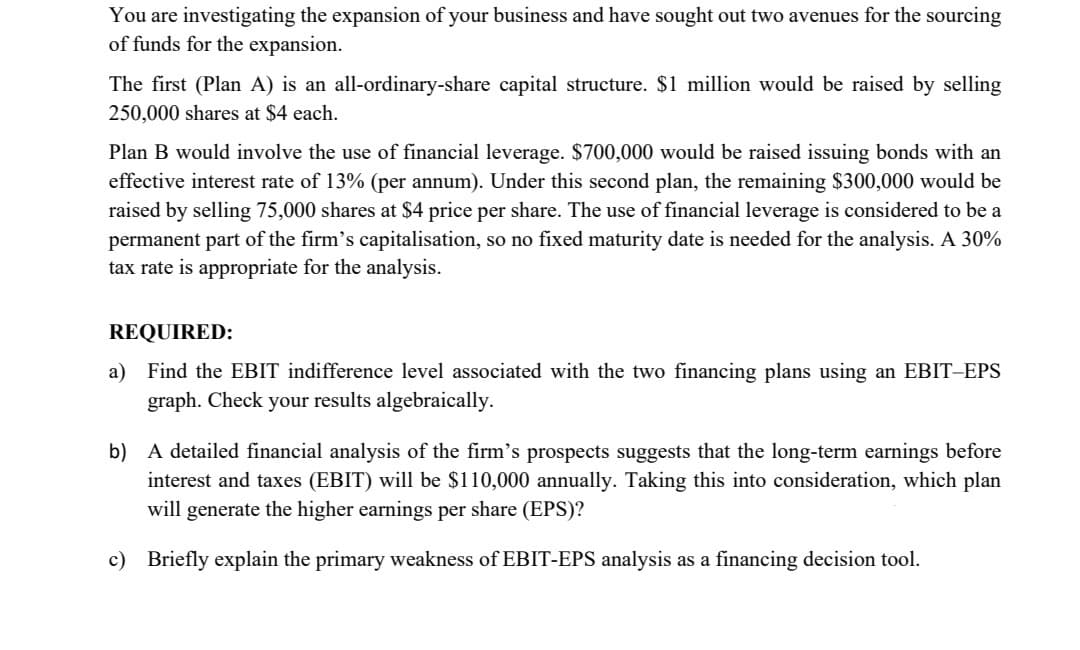You are investigating the expansion of your business and have sought out two avenues for the sourcing of funds for the expansion. The first (Plan A) is an all-ordinary-share capital structure. $1 million would be raised by selling 250,000 shares at $4 each. Plan B would involve the use of financial leverage. $700,000 would be raised issuing bonds with an effective interest rate of 13% (per annum). Under this second plan, the remaining $300,000 would be raised by selling 75,000 shares at $4 price per share. The use of financial leverage is considered to be a permanent part of the firm's capitalisation, so no fixed maturity date is needed for the analysis. A 30% tax rate is appropriate for the analysis.
You are investigating the expansion of your business and have sought out two avenues for the sourcing of funds for the expansion. The first (Plan A) is an all-ordinary-share capital structure. $1 million would be raised by selling 250,000 shares at $4 each. Plan B would involve the use of financial leverage. $700,000 would be raised issuing bonds with an effective interest rate of 13% (per annum). Under this second plan, the remaining $300,000 would be raised by selling 75,000 shares at $4 price per share. The use of financial leverage is considered to be a permanent part of the firm's capitalisation, so no fixed maturity date is needed for the analysis. A 30% tax rate is appropriate for the analysis.
Chapter14: Capital Structure Management In Practice
Section: Chapter Questions
Problem 22P
Related questions
Concept explainers
Question

Transcribed Image Text:You are investigating the expansion of your business and have sought out two avenues for the sourcing
of funds for the expansion.
The first (Plan A) is an all-ordinary-share capital structure. $1 million would be raised by selling
250,000 shares at $4 each.
Plan B would involve the use of financial leverage. $700,000 would be raised issuing bonds with an
effective interest rate of 13% (per annum). Under this second plan, the remaining $300,000 would be
raised by selling 75,000 shares at $4 price per share. The use of financial leverage is considered to be a
permanent part of the firm's capitalisation, so no fixed maturity date is needed for the analysis. A 30%
tax rate is appropriate for the analysis.
REQUIRED:
a) Find the EBIT indifference level associated with the two financing plans using an EBIT-EPS
graph. Check your results algebraically.
b) A detailed financial analysis of the firm's prospects suggests that the long-term earnings before
interest and taxes (EBIT) will be $110,000 annually. Taking this into consideration, which plan
will generate the higher earnings per share (EPS)?
c) Briefly explain the primary weakness of EBIT-EPS analysis as a financing decision tool.
Expert Solution
This question has been solved!
Explore an expertly crafted, step-by-step solution for a thorough understanding of key concepts.
Step by step
Solved in 3 steps

Knowledge Booster
Learn more about
Need a deep-dive on the concept behind this application? Look no further. Learn more about this topic, finance and related others by exploring similar questions and additional content below.Recommended textbooks for you

EBK CONTEMPORARY FINANCIAL MANAGEMENT
Finance
ISBN:
9781337514835
Author:
MOYER
Publisher:
CENGAGE LEARNING - CONSIGNMENT

Excel Applications for Accounting Principles
Accounting
ISBN:
9781111581565
Author:
Gaylord N. Smith
Publisher:
Cengage Learning

Intermediate Financial Management (MindTap Course…
Finance
ISBN:
9781337395083
Author:
Eugene F. Brigham, Phillip R. Daves
Publisher:
Cengage Learning

EBK CONTEMPORARY FINANCIAL MANAGEMENT
Finance
ISBN:
9781337514835
Author:
MOYER
Publisher:
CENGAGE LEARNING - CONSIGNMENT

Excel Applications for Accounting Principles
Accounting
ISBN:
9781111581565
Author:
Gaylord N. Smith
Publisher:
Cengage Learning

Intermediate Financial Management (MindTap Course…
Finance
ISBN:
9781337395083
Author:
Eugene F. Brigham, Phillip R. Daves
Publisher:
Cengage Learning

Financial Reporting, Financial Statement Analysis…
Finance
ISBN:
9781285190907
Author:
James M. Wahlen, Stephen P. Baginski, Mark Bradshaw
Publisher:
Cengage Learning

Intermediate Accounting: Reporting And Analysis
Accounting
ISBN:
9781337788281
Author:
James M. Wahlen, Jefferson P. Jones, Donald Pagach
Publisher:
Cengage Learning
